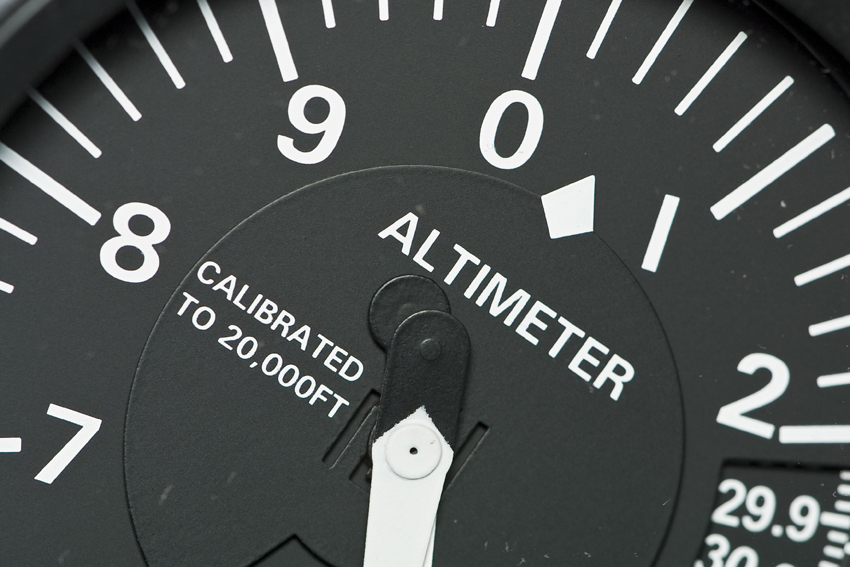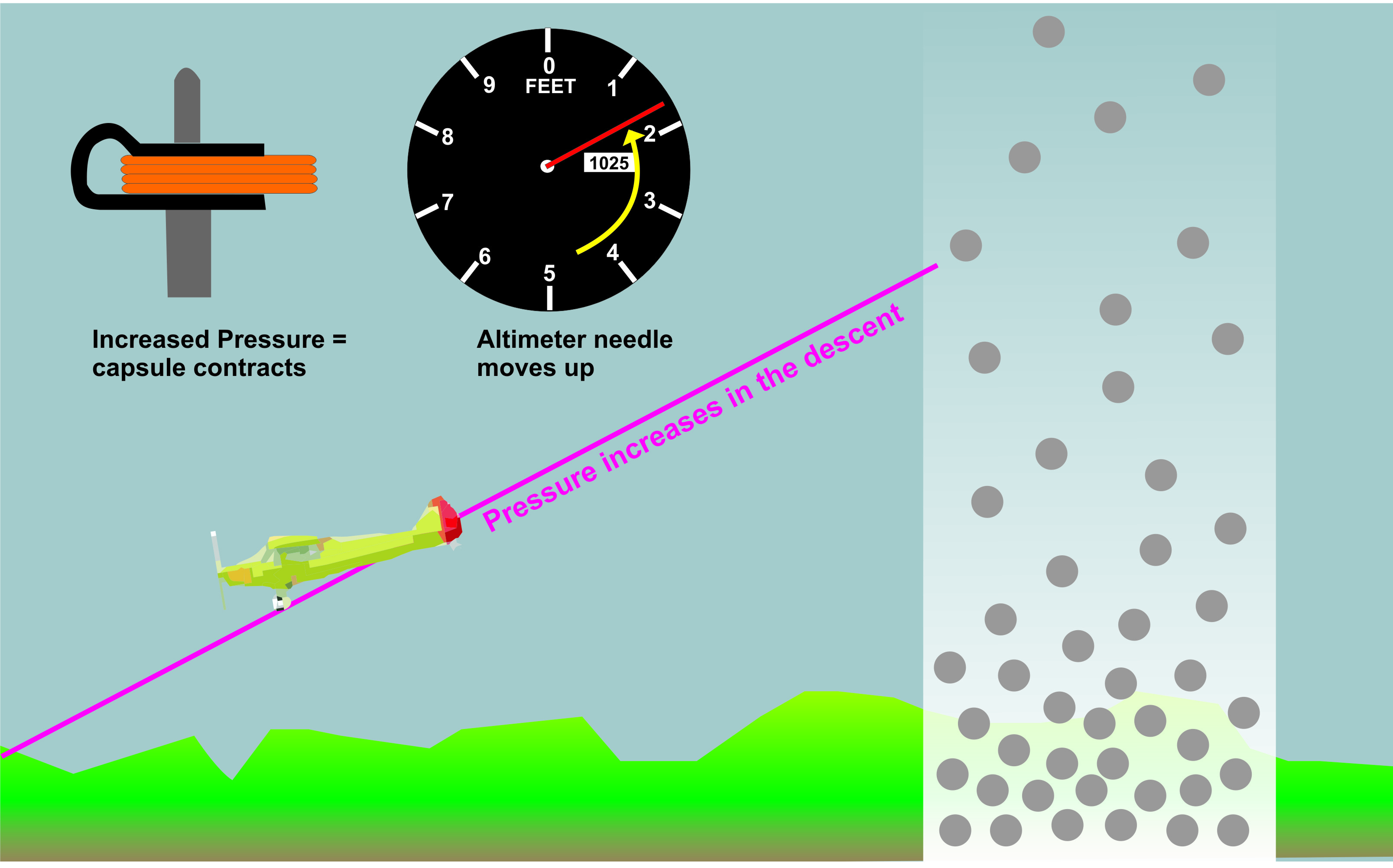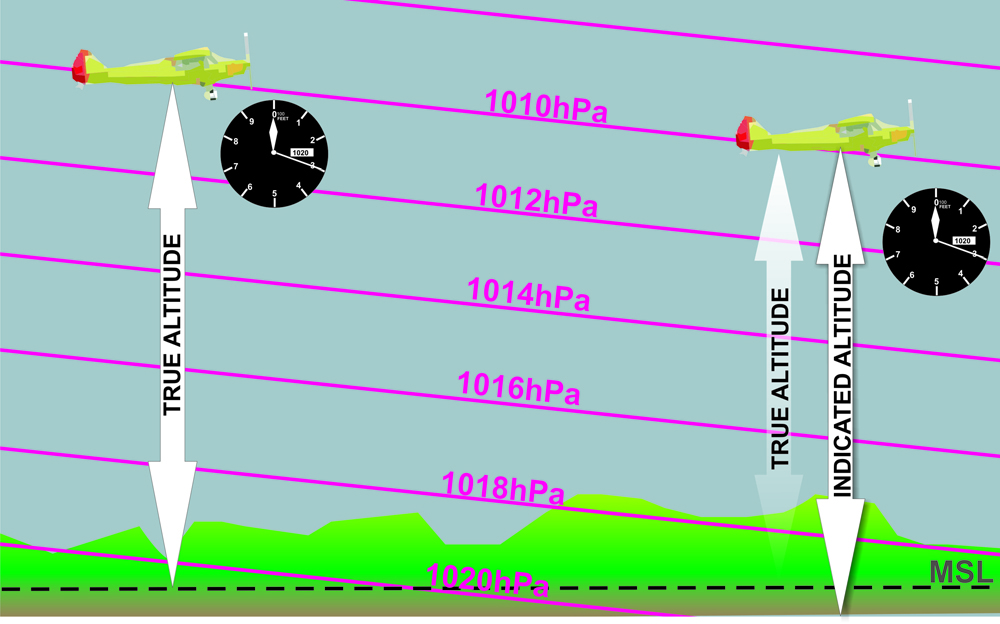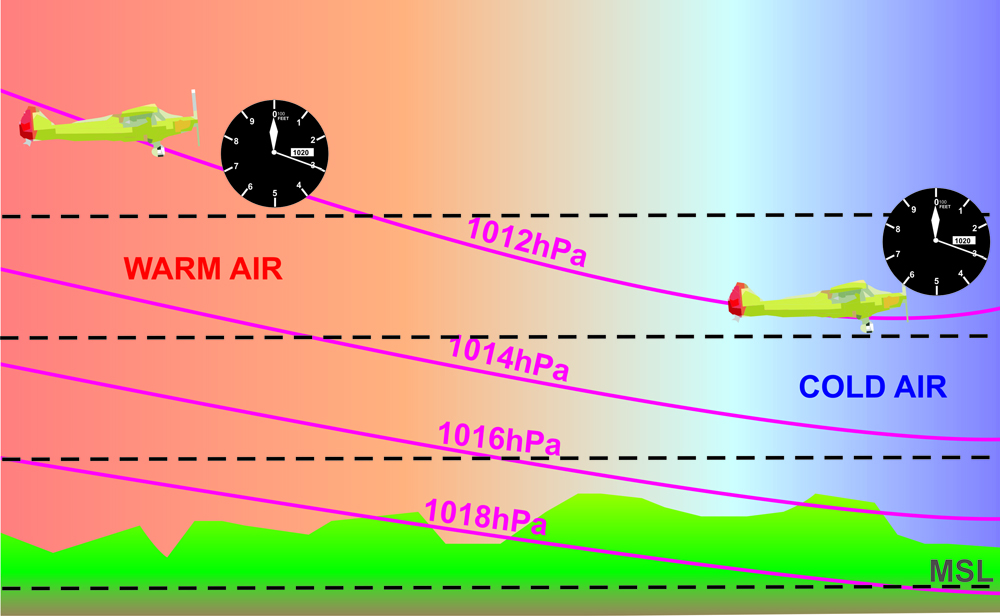
The pressure altimeter is not a fancy instrument, but despite it being invented by American Paul Kollsman, way back in 1928, not much has changed, It is, however, a rather important instrument, especially when it comes to terrain clearance, and poor visibility. As pilot, it is essential to understand how it works, the settings, and how it can lie to you…
The pressure altimeter does not directly measure what altitude you are at, rather, it measures the atmospheric pressure at the location of the aircraft. Just like a simple Barometer – if you take it to the beach it will read a higher pressure, and if you take it to the top of a mountain it will read a lower pressure. On the altimeter, the lower the pressure it senses, the higher the altitude of the aircraft.

Altimeter in the climb

Altimeter in the descent
How does the pressure altimeter work?
The pressure altimeter is fed by static pressure – this means atmospheric pressure that is not affected by airflow. The static port which feeds the altimeter is located either on the side of the fuselage, or incorporated in the pitot tube (but out of the direct airflow). The instrument itself is rather simple, consisting of an enclosed case, which is fed with static pressure. Inside the case, is a capsule containing a small partial pressure, pictured in the diagrams above.
The capsule is the reactive part of the altimeter – when the pressure decreases, as in a climb, then the capsule expands, allowing the needle on the altimeter face to move downwards, indicating a higher altitude. Conversely, when pressure increases, as is the case in a descent, then the capsule compresses, and the altimeter needle reverses direction, indicating a lower altitude.
What could go wrong?
The pressure altimeter has a number of errors which has since lead to improved versions such as the servo-assisted and radio altimeter. These errors can be significant, and if the pilot is not aware of these, there can be serious consequences, such as closure with high terrain. These are:
Instrument error – Manufacturing will never be 100% perfect, which means that there will always slight differences in readings. Added to this, wear and tear over time will also cause erroneous readings.
Position error – Inaccurate readings can be caused by a change in the position of the static ports. A change of position can be caused by manoeuvres such as turns, varying flap position, or even altering power settings.
Time lag – This is not an immediate acting instrument, so if you climb or descend, it takes a little while to react. In a climb, the pressure altimeter has a tendency to initially under-read, and in a descent, it will initially over-read.
Barometric error – As with most instruments, they require initial calibration to a specific setting. All pressure altimeters are calibrated to the ISA standard pressure of 1013hPa to ensure uniformity between all aircraft. However, if the actual atmospheric pressure is not 1013hPa, then an incorrect reading will be given. To counter act this, we set the QNH, or local pressure (according to mean sea level) by turning the subscale knob on the instrument. A difference of 1hPa will result in a difference in height of 30 feet, so it is important to always update the QNH setting.
Temperature error – Similar to the pressure error, the temperature also varies on a daily basis, and as the instrument is calibrated for the ISA standard temperature of 15 degrees. The difference can be significant, especially at higher altitudes.
What happens if you fly to areas of different pressures?
Flying from an area of higher pressure to an area of lower pressure
HIGH TO LOW CAREFUL GO – If we do not adjust the subscale setting when we fly from an area of high pressure to an area of low pressure, the altimeter will read higher than we actually are. This is particularly dangerous with regards to terrain clearance. In South Africa, the legal terrain clearance is 1500ft. If we do not adjust the setting en-route, then we may think that the terrain clearance is adequate according to the altimeter, but in fact we may be dangerously close to the terrain if there is a large pressure difference.
Flying from and area of high pressure to an area of lower pressure, the altimeter (which shows indicated altitude) will read HIGHER than what the true altitude actually is. Remember HIGH – LOW – HIGH

Flying from an area of lower pressure to an area of higher pressure.
When flying from an area of lower pressure to an area of higher pressure, the altimeter will read an altitude that is lower (indicated altitude), when in fact we are higher (true altitude).
Flying from and area of low pressure to an area of higher pressure, the altimeter (which shows indicated altitude) will read LOWER than what the true altitude actually is. Remember LOW – HIGH – LOW

What happens if we to areas of different temperature?
Flying from a higher temperature to a lower temperature.
If we fly from an area with a high temperature, to another area that has a cold temperature, whilst maintaining a constant pressure level, the indicated altitude reads correctly but we are in fact descending. When flying from HOT TO COLD DON’T BE BOLD!
Flying from and area of high temperature to an area of lower temperature, the altimeter (which shows indicated altitude) will read HIGHER than what the true altitude actually is. Remember HIGH – LOW – HIGH

Flying from a lower temperature to a higher temperature.
If we fly from a cold area to a hot area, the problem will be less serious, as we will be climbing. This will be the case, except if the temperature is below ISA for that particular altitude, where the altimeter will over-read.
Flying from and area of low temperature to an area of high temperature, the altimeter (which shows indicated altitude) will under-read the true altitude. Remember LOW – HIGH – LOW

If the temperature is COLDER than ISA – Altimeter will OVER-READ true altitude! This is dangerous especially close to ground when the pilot cannot see the ground.
What if the static vent gets blocked?
Yes, this can happen. Be it dirt, an insect or whatever else, this will cause your altimeter reading to remain unchanged in a climb or descent, as the last pressure captured, will remain inside.
This is certainly not an ideal situation to find yourself in, but there is a solution, although not entirely accurate. Some aircraft have redundancy in the form of an ‘alternate static source’ switch, or if yours doesn’t, hold back the tears and break the glass of the vertical speed indicator (VSI). This will provide you with the pressure inside the cabin, which at least provides you with something close to the atmospheric pressure, Do note, however, that it will over-read, so you will in fact be lower in altitude.
Just a final point, that Jim Davis mentions in his PPL book – ‘For an altimeter to be serviceable, its totl errors must be less than +30ft or – 60ft.



